
RGL e-Book Cover©

RGL e-Book Cover©

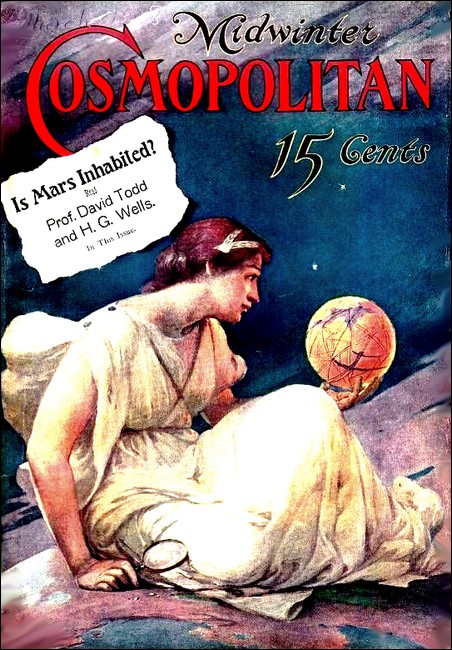
Cosmopolitan Magazine, March 1908,
with "The Things That Live On Mars"

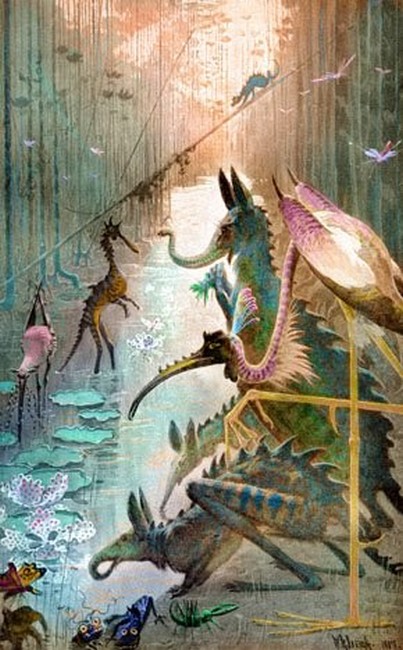
Coloured version of a Cosmopolitan illustration.
WHAT sort of inhabitants may Mars possess?
To this question I gave a certain amount of attention some years ago when I was preparing a story called "The War of the Worlds," in which the Martians are supposed to attack the earth; but since that time much valuable work has been done upon that planet, and one comes to this question again with an ampler equipment of information, and prepared to consider it from new points of view.
Particularly notable and suggestive in the new literature of the subject is the work of my friend, Mr. Percival Lowell, of the Lowell Observatory, Flagstaff, Arizona, to whose publications, and especially his "Mars and its Canals," I am greatly indebted. This book contains a full statement of the case, and a very convincing case it is, not only for the belief that Mars is habitable, but that it is inhabited by creatures of sufficient energy and engineering science to make canals beside which our greatest human achievements pale into insignificance.
He does not, however, enter into any speculation as to the form or appearance of these creatures, whether they are human, quasi-human, supermen, or creatures of a shape and likeness quite different from our own. Necessarily such an inquiry must be at present a speculation of the boldest description, a high imaginative flight. But at the same time it is by no means an unconditioned one. We are bound by certain facts and certain considerations. We are already forbidden by definite knowledge to adopt any foolish fantastic hobgoblin or any artistic ideal that comes into our heads and call it a Martian. Certain facts about Mars we definitely known, and we are not entitled to imagine any Martians that are not in accordance with these facts.

Conditions on Mars are such that the inhabitants
could utilize the direct energy of the sun's rays
to drive machinery for filling the canals.
When one speaks of Martians one is apt to think only of those canal-builders, those beings who, if we are to accept Mr. Lowell's remarkably well-sustained conclusions, now irrigate with melting polar snows and cultivate what were once the ocean-beds of their drying planet. But after all they cannot live there alone; they can be but a part of the natural history of Mars in just the same way that man is but a part of the natural history of the earth. They must have been evolved from other related types, and so we must necessarily give our attention to the general flora and fauna of this world we are invading in imagination before we can hope to deal at all reasonably with the ruling species.
And, firstly, will there be a flora and fauna at all? Is it valid to suppose that upon Mars we should find the same distinction between vegetable and animal that we have upon the earth? For the affirmative answer to that an excellent case can be made. The basis upon which all life rests on this planet is the green plant. The green plant alone is able to convert really dead inorganic matter into living substance, and this it does, as everybody knows nowadays, by the peculiar virtue of its green coloring matter, chlorophyl, in the presence of sunshine. All other animated things live directly or indirectly upon the substance of green-leaved plants. Either they eat vegetable food directly, or they eat it indirectly by eating other creatures which live on vegetable food. Now upon this earth it is manifest that nature has tried innumerable experiments and made countless beginnings. Yet she has never produced any other means than chlorophyl whereby inorganic matter, that is to say, soil and minerals and ingredients out of the air, can be built up into living matter. It is plausible, therefore, to suppose that on Mars also, if there is life, chlorophyl will lie at the base of the edifice; in other words, that there will be a vegetable kingdom. And our supposition is greatly strengthened by the fact upon which Mr. Lowell lays stress, that, as the season which corresponds to our spring arrives, those great areas of the Martian surface that were once ocean beds are suffused with a distinct bluish green hue. It is not the yellow-green of a leafing poplar or oak-tree; it is the bluish green of a springtime pine.
This all seems to justify us in assuming a flora at least upon Mars, a green vegetable kingdom after the fashion of our earthly one. Let us ask now how far we may assume likeness. Is an artist justified in drawing grass and wheat, oaks and elms and roses in a Martian landscape? Is it probable that evolution has gone upon exactly parallel lines on the two planets? Well, here again we have definite facts upon which to base our answer. We know enough to say that the vegetable forms with which we are familiar upon the earth would not "do," as people say, on Mars, and we can even indicate in general terms in what manner they would differ. They would not do because, firstly, the weight of things at the surface of Mars is not half what it would be upon the earth, and, secondly, the general atmospheric conditions are very different. Whatever else they may be the Martian herbs and trees must be adapted to these conditions.
Let us inquire how the first of these two considerations will make them differ. The force of gravity upon the surface of their planet is just three-eighths of its force upon this earth; a pound of anything here would weigh six ounces upon Mars. Therefore the stem or stalk that carries the leaves and flowers of a terrestrial plant would be needlessly and wastefully stout and strong upon Mars; the Martian stems and stalks will all be slenderer and finer and the texture of the plant itself laxer. The limit of height and size in terrestrial plants is probably determined largely by the work needed to raise nourishment from the roots to their topmost points. That work would be so much less upon Mars that it seems reasonable to expect bigger plants there than any that grow upon the earth.
Larger, slighter, slenderer; is that all we can say? No, for we have still to consider the difference in the atmosphere. This is thinner upon Mars than it is upon the earth, and it has less moisture, for we hardly ever see thick clouds there, and rain must be infrequent. Snow occurs nearly everywhere all the year round, but the commonest of all forms of precipitation upon Mars would seem to be dew and hoar frost. Now the shapes of leaves with which we are most familiar are largely determined by rainfall, by the need of supporting the hammering of raindrops and of guiding the resulting moisture downward and outward to the rootlets below. To these chief necessities we owe the hand-like arrangement of the maple- and chestnut-leaf and the beautiful tracery of fibers that forms their skeletons. These leaves are admirable in rain but ineffectual against snow and frost; snow crushes them down, frost destroys them, and with the approach of winter they are shed. But the Martian tree-leaf will be more after the fashion of a snowfall-meeting leaf, spiky perhaps like the pine-tree needle. Only, unlike the pine-tree needle, it has to meet not a snowy winter but a dry, frost-bitten, sunless winter, and then probably it will shrivel and fall. And since the great danger for a plant in a dry air is desiccation, we may expect these Martian leaves to have thick cuticles, just as the cactus has. Moreover, since moisture will come to the Martian plant mainly from below in seasonal floods from the melting of the snow-caps, and not as rain from above, the typical Martian plant will probably be tall and have its bunches and clusters of spiky bluish green leaves upon uplifting reedy stalks.
Of course there will be an infinite variety of species of plants upon Mars as upon the earth, but these will be the general characteristics of the vegetation.
Now this conception of the Martian vegetation as mainly a jungle of big, slender, stalky, lax-textured, flood-fed plants with a great shock of fleshy, rather formless leaves above, and no doubt with as various a display of flowers and fruits as our earthly flora, prepares the ground for the consideration of the Martian animals.
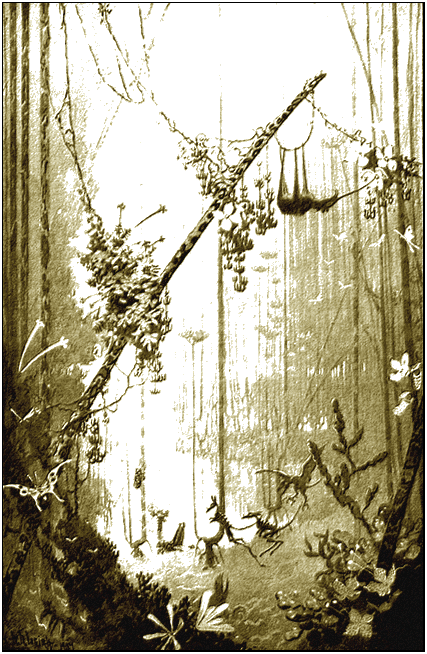
A jungle of big, slender, stalky, lax-textured, flood-fed plants
with a sort of insect lifebfluttering amidst the vegetation.
It is a matter of common knowledge nowadays how closely related is the structure of every animal to the food it consumes. Different food, different animals, has almost axiomatic value, and the very peculiar nature of the Martian flora is in itself sufficient to dispel the idea of our meeting beasts with any close analogy to terrestrial species. We shall find no flies nor sparrows nor dogs nor cats on Mars. But we shall probably find a sort of insect life fluttering high amidst the vegetation, and breeding during the summer heats in the flood-water below. In the winter it will encyst and hibernate. Its dimensions may be a little bigger than those ruling among the terrestrial insecta; but the mode of breathing by tracheal tubes, which distinguishes insects, very evidently (and very luckily for us) sets definite limits to insect size. Perhaps these limits are the same upon Mars. We cannot tell. Perhaps they are even smaller; the thinner air may preclude even the developments we find upon the earth in that particular line. Still there is plenty of justification if an artist were to draw a sort of butterfly or moth fluttering about, or ant-like creatures scampering up and down the stems of a Martian jungle. Many of them perhaps will have sharp, hard proboscides to pierce the tough cuticle of the plants.
But, and here is a curious difference, there are perhaps no fish or fish-like creatures on Mars at all. In the long Martian winter all the water seems either to drift to the poles and freeze there as snow or to freeze as ice along the water-courses; there are only flood-lakes and water-canals in spring and summer. And forms of life that trusted to gills or any method of underwater breathing must have been exterminated upon Mars ages ago. On earth the most successful air-breathing device is the lung. Lungs carry it universally. Only types of creatures that are fitted with lungs manage to grow to any considerable size out of water in our world. Even the lobsters and scorpions and spiders and such like large crustacean and insect-like forms that come up into the air can do so only by sinking their gills into deep pits to protect them from evaporation and so producing a sort of inferior imitation of a lung. Then and then only can they breathe without their breathing-organs drying up. The Martian air is thinner and drier than ours, and we conclude therefore that there is still more need than on earth for well- protected and capacious lungs. It follows that the Martian fauna will run to large chests. And the lowest types of large beast there will be amphibious creatures which will swim about and breed in the summer waters and bury themselves in mud at the approach of winter. Even these may have been competed out of existence by air-inhaling swimmers. That is the fate our terrestrial amphibia seem to be undergoing at the present time.
Here then is one indication for a picture of a Martian animal: it must be built with more lung space than the corresponding terrestrial form. And the same reason that will make the vegetation laxer and flimsier will make the forms of the Martian animal kingdom laxer and flimsier and either larger or else slenderer than earthly types.
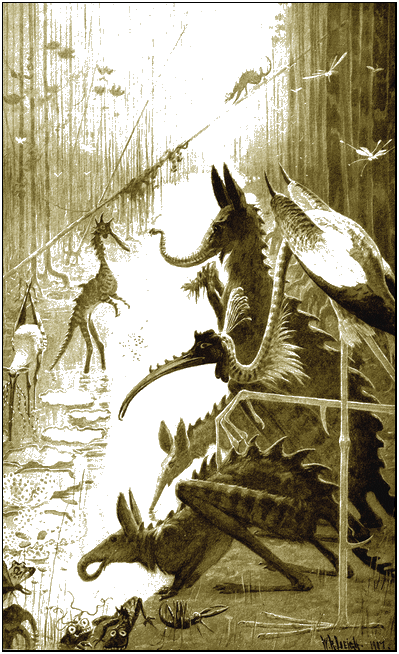
The same reason that will make the vegetation laxer and flimsier
will make the forms of the Martian animal kingdom laxer and
flimsier and either larger or else slenderer than earthly types.
Much that we have already determined comes in here again to help us to further generalizations. Since the Martian vege tation will probably run big and tall, there will be among these big- chested creatures climbing forms and leaping and flying forms, all engaged in seeking food among its crests and branches. And a thing cannot leap or fly without a well-placed head and good eyes. So an imaginative artist may put in head and eyes, and the mechanical advantages of a fore-and-aft arrangement of the body are so great that it is difficult to suppose them without some sort of back-bone. Since the Martian vegetation has become adapted to seasonal flood conditions there will be not only fliers and climbers but waders—long-legged forms. Well, here we get something—fliers, climbers, and waders, with a sort of backbone.
Now let us bring in another fact, the fact that the Martian year is just twice the length of ours and alternates between hot summer sunshine, like the sunshine we experience on high mountains, and a long, frost-bitten winter. The day, too, has the length of a terrestrial day, and because of the thin air will have just the quick changes from heat to cold we find on this planet on the high mountains. This means that all these birds and beasts must be adapted to great changes of temperature. To meet that they must be covered with some thick, air-holding, non-conducting covering, something analogous to fur or feathers, which they can molt or thin out in summer and renew for the winter's bitterness. This is much more probable than that they will be scaly or bare-skinned like our earthly lizards and snakes; and since they will need to have fur or down outside their frameworks, their skeletons, which will be made up of very light slender bones, will probably be within. Moreover, the chances are that they will be fitted with the best known contrivances for protecting their young in the earliest stages from cold and danger. On earth the best known arrangement is the one that prevails among most of the higher land animals, the device of bringing forth living young at a high stage of development. This is the "hard life" arrangement as distinguished from the easy-going, sunshiny, tropical, lay-an-egg-and-leave-it method, and Martian conditions are evidently harder than ours. So these big-chested, furry or feathery or downy Martian animals will probably be very like our mammalia in these respects. All this runs off easily and plausibly from the facts we know.
And now we are in a better position to consider those ruling inhabitants who made the gigantic canal-system of Mars, those creatures of human or superhuman intelligence, who, unless Mr. Lowell is no more than a fantastic visionary, have taken Mars in hand to rule and order and cultivate systematically and completely, as I believe some day man will take this earth. Clearly these ruling beings will have been evolved out of some species or other of those mammal-like animals, just as man has been evolved from among the land animals of this globe. Perhaps they will have exterminated all those other forms of animal life as man is said to be exterminating all the other forms of animal life here. I have written above of floods and swamps and jungles to which life has adapted itself, but perhaps that stage is over now upon Mars altogether. It must have been a long and life- molding stage, but now it may be at an end. Mr. Lowell, judging by the uniform and orderly succession of what he calls the "fallow" brown and then of the bluish green tints upon the low- lying areas of Mars, is inclined to think that this is the case and that all the fertile area of the planet has been reclaimed from nature and is under cultivation.
How far are these beings likely to resemble terrestrial humanity?
There are certain features in which they are likely to resemble us. The quasi-mammalian origin we have supposed for them implies a quasi-human appearance. They will probably have heads and eyes and backboned bodies, and since they must have big brains, because of their high intelligence, and since almost all creatures with big brains tend to have them forward in their heads near their eyes, these Martians will probably have big shapely skulls. But they will in all likelihood be larger in size than humanity, two and two-thirds times the mass of a man, perhaps. That does not mean, however, that they will be two and two-thirds times as tall, but, allowing for the laxer texture of things on Mars, it may be that they will be half as tall again when standing up. And as likely as not they will be covered with feathers or fur. I do not know, I do not know if anyone knows, why man, unlike the generality of mammals, is a bare-skinned animal. I can find, however, no necessary reason to make me believe the Martians are bare-skinned.
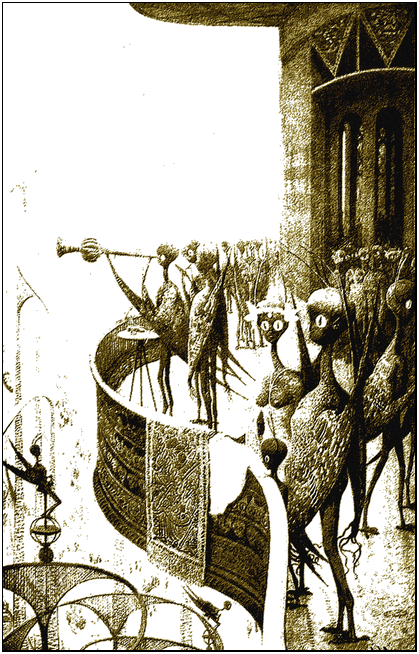
There are certain features in which they are likely to resemble
us, and as likely as not they will be covered with feathers or
fur. It is no less reasonable to suppose, instead of a hand,
a group of tentatcles or proboscis-like organs.
Will they stand up or go on four legs or six? I know of no means of answering that question with any certainty. But there are considerations that point to the Martian's being a biped. There seems to be a general advantage in a land-going animal having four legs; it is the prevailing pattern on earth, and even among the insects there is often a tendency to suppress one pair of the six legs and use only four for going. However, this condition is by no means universal. A multitude of types, like the squirrel, the rat, and the monkey, can be found which tend to use the hind legs chiefly for walking and to sit up and handle things with the fore-limbs. Such species tend to be exceptionally intelligent. There can be no doubt of the immense part the development of the hand has played in the education of the human intelligence. So that it would be quite natural to imagine the Martians as big-headed, deep-chested bipeds, grotesquely caricaturing humanity with arms and hands.
But that is only one of several almost equally plausible possibilities. One thing we may rely upon: the Martians must have some prehensile organ, primarily because the development of intelligence is almost unthinkable without it, and, secondly, because in no other way could they get their engineering done. It is stranger to our imaginations, but no less reasonable, to suppose, instead of a hand, an elephant-like proboscis, or a group of tentacles or proboscis-like organs. Nature has a limitless imagination, never repeats exactly, and perhaps, after all, the chances lie in the direction of a greater unlikeness to the human shape than these forms I have ventured to suggest.
How wild and extravagant all this reads!
One tries to picture feather-covered men nine or ten feet tall, with proboscides and several feet, and one feels a kind of disgust of the imagination. Yet wild and extravagant as these dim visions of unseen creatures may seem, it is logic and ascertained fact that forces us toward the belief that some such creatures are living now. And, after all, has the reader ever looked at a cow and tried to imagine how it would feel to come upon such a creature with its knobs and horns and queer projections suddenly for the first time?
I have purposely abstained in this paper from going on to another possibility of Martian life. Man on this earth has already done much to supplement his bodily deficiencies with artificial aids—clothes, boots, tools, corsets, false teeth, false eyes, wigs, armor, and so forth. The Martians are probably far more intellectual than men and more scientific, and beside their history the civilization of humanity is a thing of yesterday. What may they not have contrived in the way of artificial supports, artificial limbs, and the like?
Finally, here is a thought that may be reassuring to any reader who finds these Martians alarming. If a man were transferred suddenly to the surface of Mars he would find himself immensely exhilarated so soon as he had got over a slight mountain-sickness. He would weigh not one-half what he does upon the earth, he would prance and leap, he would lift twice his utmost earthly burden with case. But if a Martian came to the earth his weight would bear him down like a cope of lead. He would weigh two and two-thirds times his Martian weight, and he would probably find existence insufferable. His limbs would not support him. Perhaps he would die, self-crushed, at once. When I wrote "The War of the Worlds," in which the Martians invade the earth, I had to tackle this difficulty. It puzzled me for a time, and then I used that idea of mechanical aids, and made my Martians mere bodiless brains with tentacles, subsisting by suction without any digestive process and carrying their weight about, not on living bodies but on wonderfully devised machines. But for all that, as a reader here and there may recall, terrestrial conditions were in the end too much for them.

Coloured version of a Cosmopolitan illustration.